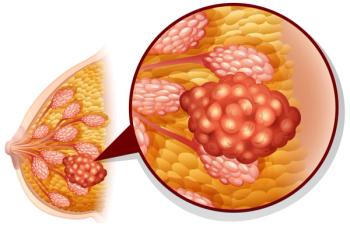
Encouraging Overall Response Rate Reported With Domvanalimab-Combinations in Non-Small Cell Lung Cancer
A 3-arm randomized study indicated that domvanalimab-based combinations yielded a promising overall response rate for patients with metastatic non–small cell lung cancer with a PD-L1 status of 50% or more.
Domvanalimab-based combinations yielded an encouraging overall response rate (ORR) when used as a first-line therapy for patients with metastatic non–small cell lung cancer (NSCLC) with a PD-L1 status of 50% or more, according to a press release on the phase 2 ARC-7 (NCT04262856) from Arcus Biosciences.
The first-interim analysis of the 3-arm study included several treatment regimens, including zimberelimab (AB122) monotherapy, domvanalimab plus zimberelimab, and domvanalimab and zimberelimab plus etrumadenant (AB928). Patients in the zimberelimab monotherapy arm had similar activity to the marketed anti-PD-1 antibodies that was studied in other companies in this setting.
There were no unexpected safety signals observed at the time of the data cutoff. All the current safety profiles for each arm were consistent with the known immune checkpoint inhibitors in this setting. The ARC-7 study, which is assessing zimberelimab alone and in combination with immunotherapy agents, will continue to enroll as planned. The ARC-7 data will be submitted later this year to be presented at a medical conference, the press release stated.
“This analysis of the dataset for the ongoing ARC-7 study revealed encouraging clinical activity for the anti-[T-cell immunoglobulin and ITIM domain (TIGIT)] domvanalimab-based combinations, and furthermore, that the anti–PD-1 zimberelimab monotherapy arm showed activity similar to that of marketed anti-PD-1 antibodies studied in this setting. Next steps are to complete enrollment in all our open domvanalimab studies, execute on our broader plans for phase 3 studies for domvanalimab across multiple cancer types, and further explore combinations with domvanalimab and etrumadenant,” Bill Grossman, MD, PhD, chief medical officer at Arcus, said in a press release.
The ARC-7 study has an estimated enrollment of 150 patients within their as first-line treatment for PD-L1 of greater than 50% and EGFR/ALK wild-type metastatic NSCLC. All participants are to be randomized 1:1:1 and will continue treatment until disease progression or loss of primary benefit.
Domvanalimab is an Fc-silent investigational monoclonal antibody that binds to TIGIT. Domvanalimab binds to the TIGIT. This mechanism frees immune activating pathways and activate immune cells to attack and kill cancer cells which can often avoid detection in the immune system.
The primary end points of the study are ORR and progression-free survival. Key secondary end points include duration of response, disease control rate, and safety profile.
Patients who enrolled on the trial were required to have histologically-confirmed squamous or non-squamous, PD-L1–positive metastatic NSCLC without sensitizing EGFR receptor or ALK mutation expression. Additionally, an ECOG performance status of 0 or 1, and at least 1 measurable lesion per RECISIT v1.1 were required for enrollment.
Domvanalimab plus zimberelimab is additionally being examined in the ongoing phase 3 ARC-10 trial, which is comparing the regimen with zimberelimab alone, as well as platinum-based chemotherapy in first line setting for patients with locally advanced or metastatic, NSCLC with a PD-L1 status of more than 50%. Additional phase 3 studies are being planned based on ARC-7 data that will examine domvanalimab-combinations across various types of solid cancer.
Arcus is currently developing another anti-TIGIT agent, AB308, that is currently being examined in phase 1 studies for advanced malignancies with a potential focus on hematologic malignancies.
Reference
Anti-TIGIT domvanalimab-based combinations showed encouraging clinical activity in people with metastatic, PDL1-high non-small cell lung cancer at first interim analysis of Arcus Biosciences’ randomized phase 2 ARC-7 study. News Release. Arcus Biosciences. June 23, 2021. Accessed September 2, 2021. https://bwnews.pr/3mVLdIN
Newsletter
Stay up to date on recent advances in the multidisciplinary approach to cancer.





















































































